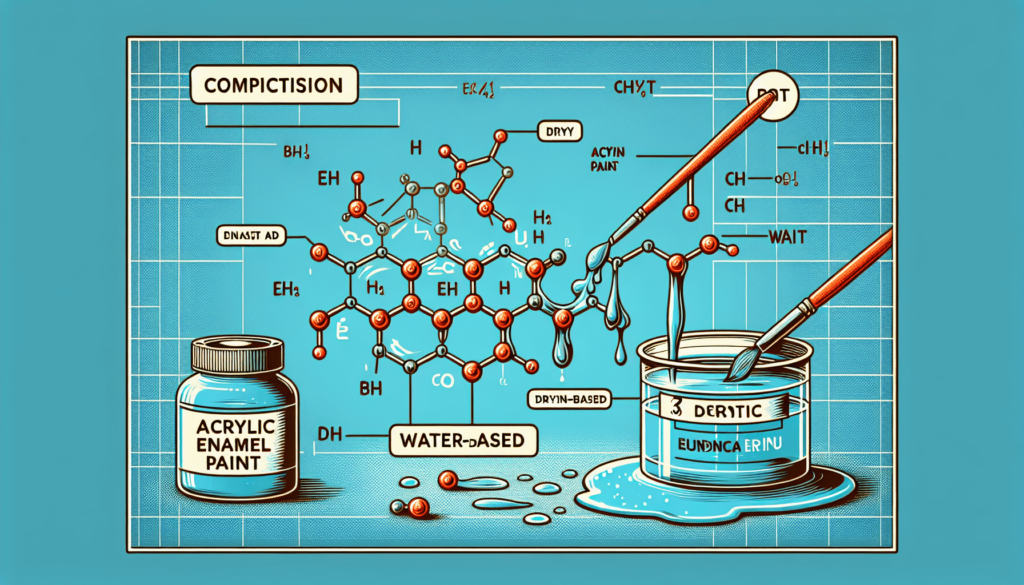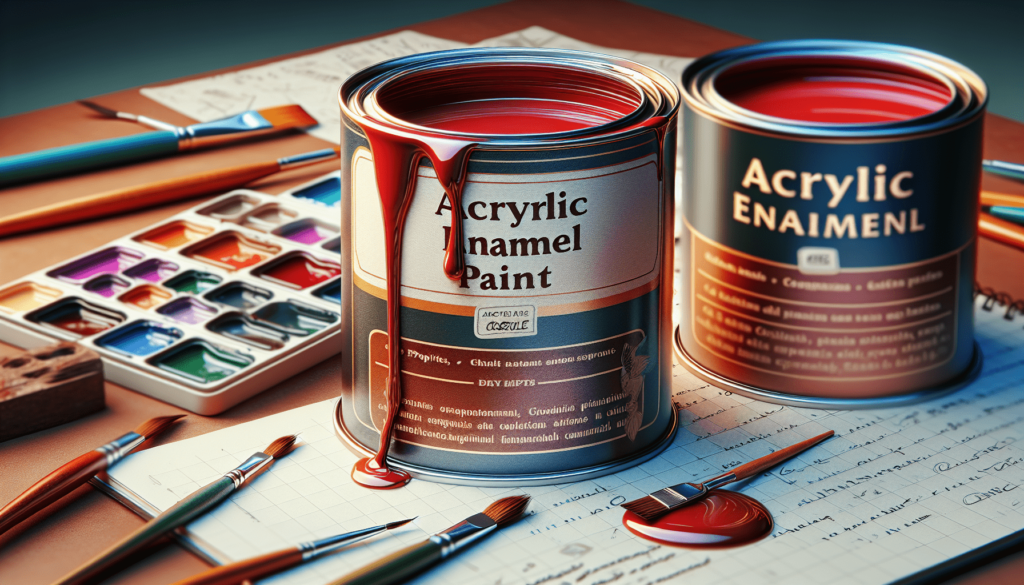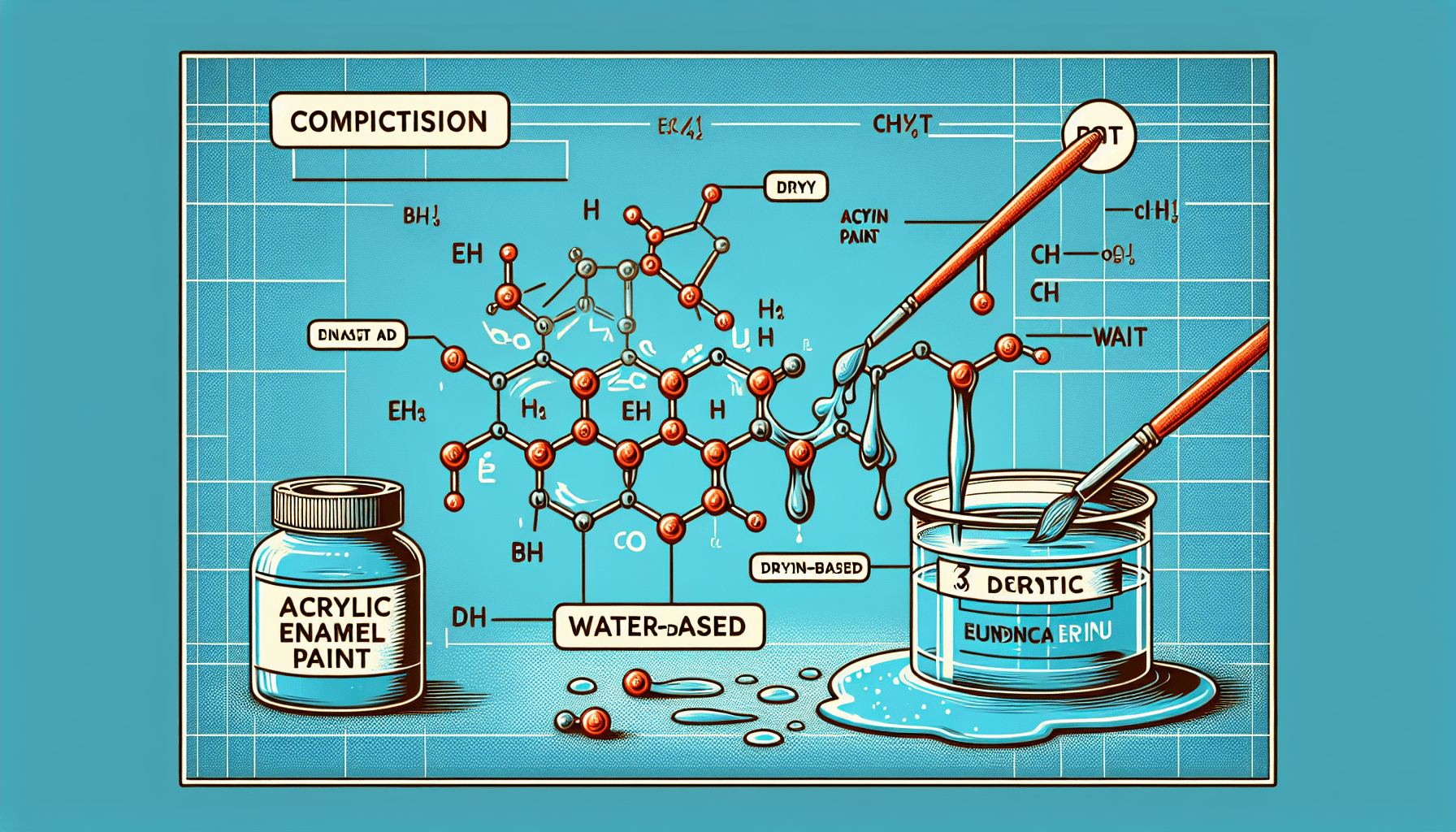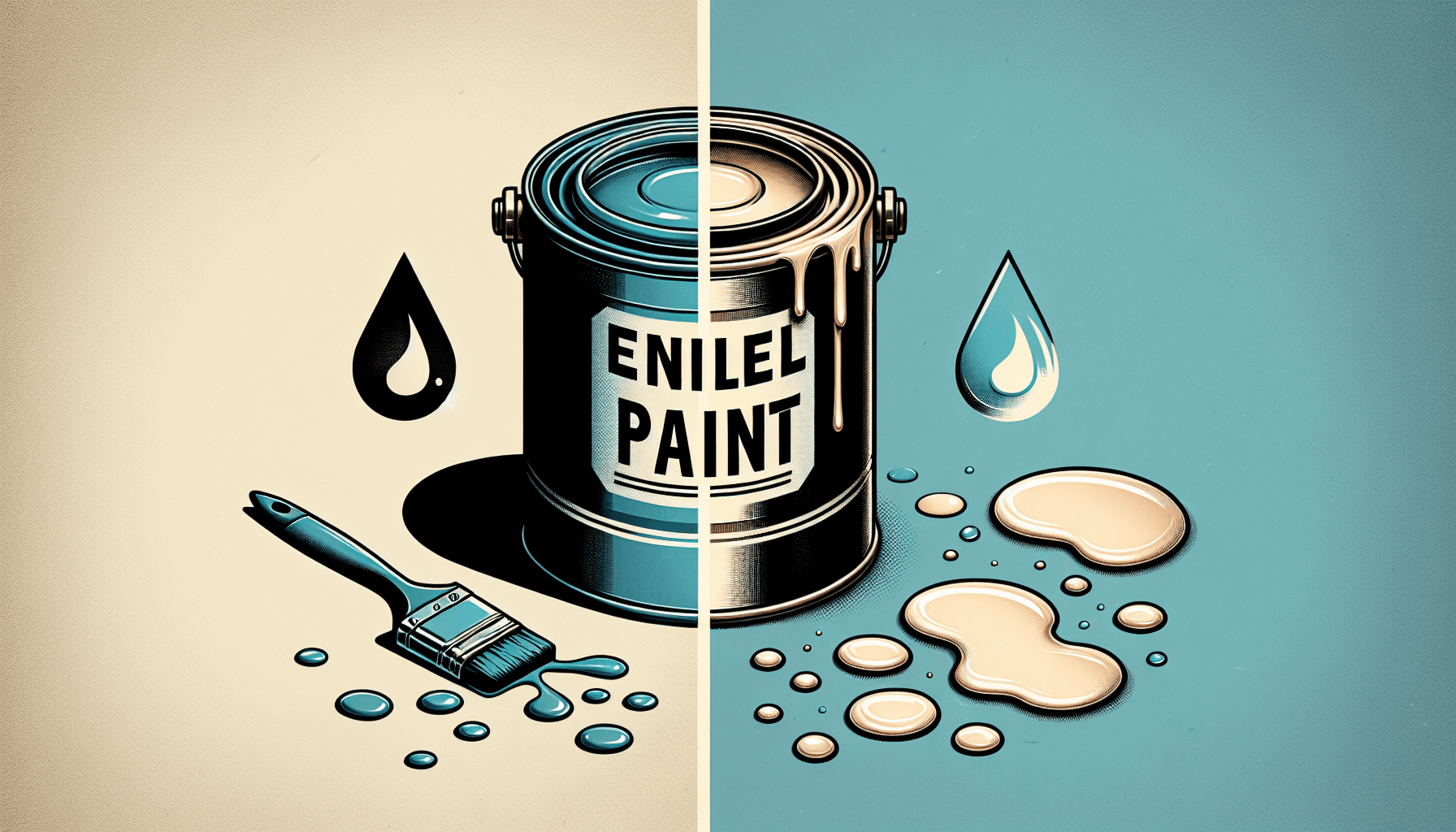Acrylic enamel paint has become increasingly popular among artists, DIY enthusiasts, and professionals alike due to its exceptional durability and vibrant color options. However, when it comes to understanding its composition, confusion often arises as to whether acrylic enamel paint is water-based or not. In this article, we will explore the nature of acrylic enamel paint, its key characteristics, and demystify the common misconception surrounding its water-based properties. By shedding light on this topic, we aim to provide a clearer understanding of this versatile paint medium and aid individuals in making informed choices for their artistic or practical endeavors.
What is Acrylic Enamel Paint?
Description of Acrylic Enamel Paint
Acrylic enamel paint is a type of paint commonly used for various applications, including automotive painting, household projects, and artistic purposes. It is known for its durability, vibrant colors, and excellent adhesion to different surfaces. Acrylic enamel paint consists of pigments suspended in an acrylic polymer emulsion, which provides a smooth and glossy finish when dry. It is widely used due to its versatility and ability to adhere to various materials, such as metal, wood, and plastic.
Chemical Composition of Acrylic Enamel Paint
Acrylic enamel paint is primarily composed of pigment particles, acrylic polymer binders, solvents, and additives. Pigments are responsible for the color of the paint and come in both organic and inorganic forms. The acrylic polymer binders act as a medium to hold the pigments together and adhere them to the painted surface. Solvents, such as water or specific organic solvents, are added to control the paint’s viscosity and facilitate application. Additives, such as leveling agents, UV stabilizers, and flow improvers, may also be included to enhance specific paint properties.
Water Based Paints
Definition of Water Based Paints
Water-based paints, also known as latex paints, are a type of paint in which water serves as the primary carrier or solvent. These paints have a lower concentration of volatile organic compounds (VOCs) compared to solvent-based paints, making them less harmful to human health and the environment. Water-based paints have gained popularity due to their ease of use, quick drying time, and low odor.
Advantages of Water Based Paints
Water-based paints have several advantages over solvent-based paints. Firstly, they have a lower odor, making them more pleasant to work with and suitable for indoor applications. Secondly, water-based paints are easy to clean up with just soap and water, reducing the need for harsh solvents. Additionally, they have a quicker drying time, allowing for faster project completion. Water-based paints also have a lower VOC content, contributing to better indoor air quality and a reduced environmental impact.

Characteristics of Acrylic Enamel Paint
Drying Time
Acrylic enamel paint has a relatively quick drying time compared to other types of paint. Depending on the thickness of the applied coat and environmental conditions, it typically dries to the touch within 1-2 hours. However, it is essential to note that full curing and maximum hardness may take several days or even weeks, depending on the specific product and conditions.
Toxicity Level
Acrylic enamel paint generally has a low toxicity level, especially when compared to oil-based paints. The use of water as a solvent in acrylic enamel paints significantly reduces the release of harmful volatile organic compounds (VOCs) into the air. However, it is still essential to follow safety precautions, such as adequate ventilation and the use of respiratory protection, when working with any type of paint.
Odor
Acrylic enamel paint has a relatively low odor compared to oil-based paints, making it more suitable for indoor projects and areas with limited ventilation. The use of water as a solvent significantly reduces the strong chemical odor associated with traditional solvent-based paints. However, it is still recommended to provide proper ventilation when using acrylic enamel paint to minimize any potential odor.
Durability
One of the key characteristics of acrylic enamel paint is its exceptional durability. When fully cured, acrylic enamel forms a hard, protective coating that is resistant to various external factors such as weather conditions, UV radiation, and moisture. It provides good adhesion to different surfaces and offers a long-lasting finish that can withstand frequent handling and exposure to everyday wear and tear.
Comparison with Other Types of Paints
Acrylic Enamel vs. Oil-based Enamel
Acrylic enamel paint and oil-based enamel paint are two commonly used paints, but they differ in several aspects. Acrylic enamel paint uses water as a solvent and has a lower VOC content, making it more environmentally friendly and safer to use. On the other hand, oil-based enamel paint requires mineral spirits or turpentine as a solvent and has a higher VOC content. Oil-based enamel tends to have a stronger odor and takes longer to dry and cure compared to acrylic enamel paint. However, oil-based enamel may provide a smoother and more durable finish on certain surfaces.
Acrylic Enamel vs. Latex Paint
Although both acrylic enamel paint and latex paint are water-based, they have distinct characteristics. Acrylic enamel paint contains acrylic polymers, which give it superior durability and adhesion to various surfaces. It is commonly used for automotive painting and other applications that require a high level of resilience. On the other hand, latex paint is typically used for interior and exterior walls in residential and commercial settings. It is known for its ease of application, quick drying time, and affordability. Latex paint may not have the same level of durability and gloss as acrylic enamel paint.

Manufacturing Process of Acrylic Enamel Paint
Ingredients
The manufacturing process of acrylic enamel paint involves several key ingredients. These include pigments, acrylic polymer binders, solvents, and additives. Pigments provide color and come in various forms, such as powders or liquid dispersions. Acrylic polymer binders act as a medium to bind the pigments together and provide adhesion to the painted surface. Solvents, such as water or specific organic solvents, are added to control the paint’s viscosity and facilitate application. Additives such as leveling agents, UV stabilizers, and flow improvers may also be incorporated to enhance specific paint properties.
Production Steps
The production of acrylic enamel paint typically involves the following steps:
-
Weighing and Mixing: The required amounts of pigments, acrylic polymer binders, solvents, and additives are accurately weighed and mixed in a controlled environment to ensure consistency and quality.
-
Dispersion: The pigments are dispersed in the acrylic polymer emulsion to ensure a homogeneous mixture and uniform color distribution.
-
Grinding: The pigment dispersion is then subjected to a grinding process, such as bead milling, to break down pigment aggregates and achieve a finer particle size. This step helps in improving the paint’s opacity and color intensity.
-
Letdown: The ground pigment dispersion is mixed with additional acrylic polymer emulsion, solvents, and additives to adjust the rheology, color, and final paint properties. The mixture is thoroughly blended to ensure uniformity.
-
Quality Control and Packaging: The final paint formulation is subjected to rigorous quality control tests to ensure consistency, color accuracy, and other desired properties. Once approved, the paint is packaged into containers suitable for storage, transportation, and consumer use.
Distinction between Acrylic and Enamel Paints
Definition of Acrylic Paint
Acrylic paint is a type of paint consisting of pigments suspended in an acrylic polymer emulsion. It is known for its water-based nature, quick drying time, and versatility. Acrylic paint offers excellent adhesion to various surfaces, including canvas, wood, metal, and plastic. It can be used for a wide range of applications, from fine art to crafts and DIY projects.
Definition of Enamel Paint
Enamel paint is a broad term used to describe paints that dry to a hard, durable, and glossy finish. Traditionally, enamel paints were oil-based and had a high VOC content. However, modern enamel paints can be water-based (acrylic enamel paint), oil-based, or even synthetic-based. Enamel paints are commonly used for surfaces that require a tough and long-lasting finish, such as metal, ceramics, and certain plastics.
Key Differences
The main difference between acrylic paint and enamel paint lies in their chemical composition and drying process. Acrylic paint uses water as a solvent, dries through evaporation, and forms a flexible but durable coating. Enamel paint, on the other hand, can be water-based or oil-based and dries through oxidation or polymerization, resulting in a hard and glossy surface. Acrylic paint is generally easier to clean up and has a lower VOC content compared to enamel paint. Enamel paint, particularly oil-based enamel, may offer a smoother and more durable finish, especially on metal surfaces.
Water-based Acrylic Enamel Paints
Introduction to Water-based Acrylic Enamel Paints
Water-based acrylic enamel paints combine the benefits of acrylic paint and enamel paint. These paints use acrylic polymer emulsions as binders but are formulated to provide a more durable and glossy finish similar to traditional enamel paints. They offer excellent adhesion, color retention, and resistance to chipping, cracking, and fading. Water-based acrylic enamel paints are commonly used for various applications, including automotive painting, furniture refinishing, and decorative crafts.
Advantages of Water-based Acrylic Enamel Paints
Water-based acrylic enamel paints offer several advantages over traditional enamel paints. Firstly, they have a lower VOC content, making them safer for both the environment and human health. Secondly, these paints dry relatively quickly and have a faster curing time compared to oil-based enamel paints. They can be cleaned up easily with soap and water, reducing the need for harsh solvents. Water-based acrylic enamel paints also provide excellent color retention and durability, making them suitable for both indoor and outdoor projects.
How Acrylic Enamel Paints Work
Adhesion
Acrylic enamel paints are formulated to adhere well to a variety of surfaces, including metal, wood, plastic, and more. The acrylic polymer binders in the paint create a strong bond with the painted surface, ensuring good adhesion and preventing peeling or flaking. However, proper surface preparation, such as cleaning and sanding, is crucial to enhance adhesion and ensure a long-lasting finish.
Curing Process
The curing process of acrylic enamel paint involves the evaporation of water or other solvents and the chemical crosslinking of the acrylic polymer binders. As the paint dries, the water or solvents evaporate, allowing the acrylic polymers to come into close contact and form a continuous film. This process is accelerated by heat and air circulation, facilitating faster drying and curing. While the paint may feel dry to the touch within a few hours, it takes additional time for the acrylic polymers to fully crosslink and achieve maximum hardness and durability.
Durability
Acrylic enamel paint is well-regarded for its durability. Once fully cured, it forms a robust and protective coating that can withstand daily wear and tear, UV radiation, moisture, and temperature variations. The paint’s durability is enhanced by the chemical crosslinking of the acrylic polymers, creating a strong network of intermolecular bonds. The result is a long-lasting finish that retains its color and gloss for extended periods, making acrylic enamel paint suitable for high-traffic areas or surfaces exposed to harsh conditions.
Usage and Applications of Acrylic Enamel Paints
Automotive Industry
Acrylic enamel paints are widely used in the automotive industry for painting vehicles and automotive parts. The durability, color retention, and glossy finish of acrylic enamel make it a popular choice for achieving a professional and long-lasting automotive paint job. Whether it’s a complete vehicle repaint or touch-up work, acrylic enamel paints offer excellent adhesion to the vehicle’s metal surfaces, providing protection against corrosion and environmental damage.
Household Projects
Acrylic enamel paints find numerous applications in household projects, both indoors and outdoors. They can be used for painting walls, furniture, cabinets, doors, trim, and other surfaces. The range of available colors and finishes allows homeowners to achieve their desired look and enhance the aesthetic appeal of their living spaces. Acrylic enamel paints are known for their easy application, quick drying time, and low odor, making them suitable for DIY enthusiasts and professionals alike.
Artistic Purposes
Artists often choose acrylic enamel paint due to its versatility, vibrant colors, and ease of use. It can be used on various artistic mediums, such as canvas, paper, wood, and more. Acrylic enamel provides excellent color mixing capabilities, allowing artists to create a wide range of hues and shades. The quick drying time of acrylic enamel enables artists to layer and work with different techniques without waiting for extended periods. The durable finish of acrylic enamel ensures that artwork remains vibrant and protected over time.
Conclusion
Summary of Acrylic Enamel Paint
Acrylic enamel paint is a versatile and durable paint that finds applications in numerous industries and projects. It consists of pigments suspended in an acrylic polymer emulsion, providing excellent adhesion, color retention, and resistance to various external factors. Acrylic enamel dries relatively quickly, but full curing may take several days or weeks, depending on the conditions. It has a low toxicity level, low odor, and offers a glossy finish that can withstand everyday wear and tear.
Recommended Uses
Acrylic enamel paint is recommended for automotive painting, household projects, and artistic purposes. In the automotive industry, it provides a long-lasting and professional finish that protects against corrosion and environmental damage. For household projects, it offers a quick and easy way to enhance the appearance of walls, furniture, and other surfaces. Artists can rely on acrylic enamel paint for its vibrant colors, versatility, and durability in creating captivating artworks.
Final Thoughts
Acrylic enamel paint, with its unique combination of properties, has become a popular choice for various applications. Its water-based nature, low toxicity level, and ease of use make it a preferable option for those seeking a more environmentally friendly and user-friendly paint. Whether you’re a professional painter, a DIY enthusiast, or an artist, acrylic enamel paint provides excellent coverage, adhesion, and durability, allowing you to achieve impressive results in your projects.



